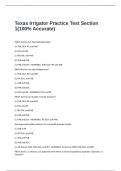Texas Irrigator Practice Test Section
1(100% Accurate)
Which devices can stop backsiphonage?
a). PVB, DCA, RP, and AVB
b). DCA and RP
c). RP, DCA, and PVB
d). AVB and PVB
e). PVB and DCA - ANSWERa). PVB, DCA, RP, and AVB
Which devices can stop backpressure?
a). PVB, DCA, RP, and AVB
b). RP, DCA, and PVB
c). AVB and PVB
d). PVB and DCA
e). DCA and RP - ANSWERe). DCA and RP
Which devices can handle constant pressure?
a). PVB, DCA, RP, and AVB
b). DCA and RP
c). RP, DCA, and PVB
d). AVB and PVB
e). PVB and DCA - ANSWERc). RP, DCA, and PVB
The approved backflow devices for non-health hazards include:
a). AVB & RP
b). RP, DCA, and PVB
c). AVB and PVB
d). PVB and DCA
e). All devices (AVB, PVB, DCA, and RP) - ANSWERe). All devices (AVB, PVB, DCA, and RP)
Which device, or devices, are approved when there is chemical applied by aspiration, injection, or
emission?
, a). AVB
b). PVB
c). DCA and RP
d). PVB, DCA, and RP
e). RP - ANSWERe). RP
If there is an on-site sewage facility on site, which backflow is approved?
a). AVB
b). PVB
c). DCA
d). RP
e). B & C - ANSWERd). RP
If major maintenance has to be performed, which backflow device has to be properly installed prior
to the repair work being performed?
a). An approved backflow device
b). PVB
c). DCA or PVB d). RP
e). B & C - ANSWERa). An approved backflow device
If including a master valve, where does it have to be installed?
a). Upstream from the AVB
b). Downstream from the PVB
c). Before the backflow device
d). Downstream from the PVB, DCA, or RP
e). None of the above - ANSWERd). Downstream from the PVB, DCA, or RP
Which devices have to be tested upon installation and annually?
a). AVB and RP
b). Devices used in applications designated as health hazards
c). DCA
d). RP
e). Devices used in applications designated as non-health hazards - ANSWERb). Devices used in
applications designated as health hazards
Which backflow devices have to be tested upon installation?
a). AVB and RP




